|
< Earlier Kibitzing · PAGE 20 OF 39 ·
Later Kibitzing> |
| Mar-02-19 | | scholes: Current training of Leela chess zero is using a newer version of this network architecture
https://arxiv.org/abs/1709.01507
This network architecture is different in sense that by using a global pooling layer it allows network to learn relative importance of features that it learns. There are two ways to predict final strength of network architecture. Leela chess zero has a standard dataset of chess games. To test if a new architecture is promising they do supervised training on that dataset. When new architecture was tested that way it was observed that it had similar training error as 40 block network of previous architecture. And it was 150 ELO stronger than baseline. Secondly the training of test 40 (new architecture) is ongoing. It has only one learning rate drop so far. It is already as strong as test 30 ( tcec superfinal net) at very large node counts http://talkchess.com/forum3/viewtop... |
|
Mar-02-19
 | | AylerKupp: <scholes> Thanks. I looked at the first reference but it demands far more careful reading and learning that I can devote to it at this time. But I looked at the second reference and I don't understand it at all because (partly) I don't have any background on the test nets. But some things don't make much sense to me because of my limited knowledge; e.g. Elo differences of -24.36 ±45.86 (TC10 @ 0.25m + 0.25s) and +8.69 ±61.92 Oh, I know what it superficially means but not what it <really> means. But, I don't really need to know. And, of course, chess engines are continuously evolving so what is good today will likely be even better tomorrow. BTW, what do you think of my arguments that in order to determine which chess engine <software> yields better results the various chess engines must execute in <hardware> of similar computational capability? The hardware architecture need not be the same but they should be able to perform a similar number of comparable operations per unit time. Do you think that there are alternate ways? Of course, it's still useful, interesting, and important to be able to see how different software+hardware architectures perform since it might point out new and better software architecture approaches. |
|
Mar-02-19
 | | Sally Simpson: ***
Hi scholes,
"But since it seems stockfish is very close to perfect chess." Do we want perfect chess? Would we play over games with perfect chess? Do we marvel at the juggler juggling four bowling balls or are we wanting to see one fall on his foot. Do we want to see time and time again Evel Knievel successfully jumping over 20 buses or are we watching to see if he smashes into one. We can all enjoy a well played game apparently void of any mistake but no game can be won unless a player blunders and it's blunders, big, small or grotesque we want. Can a human learn anything about human v human games from perfect chess. Here: Alekhine vs H Wolf, 1922 
click for larger viewWolf played 35...Rxa3 setting a really sneaky trap which was waiting to be sprung here. 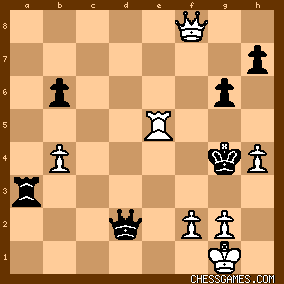
click for larger view40.f3+ Kg3 41. Rg5+ Qxg5! and 0-1. ALekhine avoided it but mentioned it in his notes so appreciated it. A perfect chess engine would never play 35...Rxa3 they play without hope. Stockfish et alia are great for analysis, though even then they would fail to mention the above trap thus robbing us of an instructive idea and lesson 'always stay alert'. When I go to watch a horror film I want to be entertained, scared, be giving a fright, surprised (and see the beastie come back to life again when you think it's dead.) There are no ghosts in computer perfect games, the beastie stays dead. *** |
|
Mar-02-19
 | | alexmagnus: If preselected openings in TCEC are to avoid draws, they are doing a bad job. And why would it be more drawn without preselected openings? I mean, opening books are banned anyway, so what's the matter with pre-selecting openings? It's not like the engines can play 30 or so book moves on their own. |
|
Mar-02-19
 | | alexmagnus: Anf FR would not change it by the way. For the very same reason - they are playing without books anyway. |
|
| Mar-02-19 | | scholes: <Sally> That's why alphazero made 494 draws out of 500 games against stockfish when it played from black side. |
|
| Mar-03-19 | | MrMelad: <scholes: Current training of Leela chess zero is using a newer version of this network architecture https://arxiv.org/abs/1709.01507> Thank you for this information, very interesting! |
|
Mar-03-19
 | | HeMateMe: <Do we want to see time and time again Evel Knievel successfully jumping over 20 buses or are we watching to see if he smashes into one.> I was hoping the Evel Knievel 'rocket cycle' would hit the rock face on the opposite side of the Snake River Canyon. Sorry. |
|
| Mar-06-19 | | Momentum Man: I think I found the best board on this entire website! And it took me the better part of 4 days. |
|
| Mar-06-19 | | diceman: <Sally Simpson: ***
Do we want perfect chess? Would we play over games with perfect chess?> The World Chess Championship is getting difficult to watch. The sad thing, it seems more lazy chess vs perfect chess. |
|
Mar-07-19
 | | offramp: <Momentum Man: I think I found the best board on this entire website!
And it took me the better part of 4 days.> Most game pages are very slow-moving; they remind me of that <pitch-drop experiment>.
Take for example Spassky vs D Hepner, 1986.
There are 23 comments spaced out over 12 years, but nothing for the last three years.
The comments range from one sentence criticisms to a full set of annotations by one of the players.
So if you post a comment at a specific chess game you never know when or if you will get a reply, nor what form that reply will take. There are millions of games and only a small number of active posters. The Kibitzer's Café and Rogoff are the ramblings of deranged individuals (as you found out), so I suppose here is as good a place as any for general chess chat. |
|
Mar-07-19
 | | offramp: <AylerKupp: "Just because you're not paranoid doesn't mean that everyone is not out to get you."> There is also pronoia, which is the belief that people are secretly trying to help you. |
|
Mar-08-19
 | | keypusher: <Hi scholes,
"But since it seems stockfish is very close to perfect chess."
Do we want perfect chess? >
Hi Sally, is it Stupid Rhetorical Question Time? Is it EVER Stupid Rhetorical Question Time? Did scholes give the slightest hint that he thought that perfect chess (whatever that is) was desirable?
Anyway, the answer to your SRQ is “yes, sometimes.” <Can a human learn anything about human v human games from perfect chess.> Substituting <super-strong engine chess> for <“perfect chess”>: yes, of course. Can the human learn <everything> about human v. human chess from <SSEC>? No, of course not. I will say, the illustrative trap you give here is less absurd than the wouldn’t-fool-a-D-player examples you used to post. I take full credit for your improvement. But, you know, lots of humans wouldn’t play 35….Rxa3 either, because it allows a forced mate for White, and even if you can’t work that out over the board (I certainly couldn’t) Black’s obviously leaving his king defenseless. I wouldn’t say it’s a particularly good trap myself, since it gets “sprung” five moves later, requires White to completely forget about his own king’s safety to work, and leaves white with many winning lines. <A perfect chess engine would never play 35...Rxa3 they play without hope.
Stockfish et alia are great for analysis, though even then they would fail to mention the above trap thus robbing us of an instructive idea and lesson 'always stay alert'.> <they play without hope> is not even true of conventional engines IMO, but it’s definitely false for A0, since its MCTS analysis tends to prize lines that give its opponent chances to go wrong, and when it’s in what it thinks is a bad position it tends to go in for traps and complications, just as (some) strong human players do. See Stockfish vs AlphaZero, 2018 and Stockfish vs AlphaZero, 2018. Anyway, here’s a game you ought to like, even though a computer played it, since it involves basically sacrificing Black’s queenside for an all-out kingside attack. It isn’t in the database, and was (I think) played at a faster time control that the match games (G/18 with a 1.5-second increment). It’s one of 140 games that Sadler had DeepMind play to test how A0 would play against the English or against 1.d4, 2.c4 as Black and against the King’s Indian or Gruenfeld as White. See <Game Changer> at 407. Comments from <Game Changer> are in chevrons (< >), with my comments (mostly my SF10’s comments, really) in plain text or, if I’m commenting within a <Game Changer> note, in square brackets. This is going to require multiple posts. |
|
Mar-08-19
 | | keypusher: I 1.c4
<In these games, I stipulated 1.c4 as the opening move for White. AlphaZero always reacted the same way.> 1….e5 2.Nc3 Nf6 3.Nf3 Nc6 4.e3 Bb4 5.Qc2 Bxc3 6.Qxc3 Qe7 7.Be2 0-0 8.d4 e4 9.Ne5 <Varying from the game Osmanovic-Hort, Decin 1979 [not in the database], when 9.Nd2 was played.> 9….Nd8 10.h3 h5
<Played to threaten to trap the knight with …d7-d6 rather than to start a kingside attack, but not a move that AlphaZero is unhappy with in general.> 11.c5 d6 12.cxd6 cxd6 13.Nc4 b5
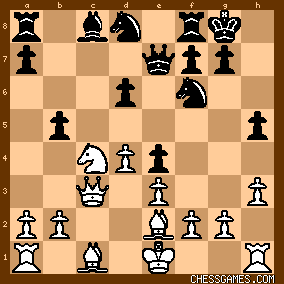
click for larger view<An unexpected move that is part of a far-reaching plan to develop Black’s pieces to their most active squares and to simultaneously disrupt White’s coordination. The white knight was well-placed on c4, targeting the d6-pawn. If White could consolidate the queenside pawn structure with a2-a4 followed by b2-b3 and Ba3, then its pieces would exert irritating pressure on Black’s position. From that point of view, 13….b5 is understandable. However, it feels loosening; the b5-pawn is under attack from the bishop on e2 (and can be further attacked by a2-a4) while from a5 the white knight cannot be attacked by a pawn, eyes the outpost on c6, and takes away the most natural square for the knight on d8.However, this is where the second part of AlphaZero’s plan comes into view: Black is not planning to place the knight on its natural c6 square, but on its best square: d5. There it is invulnerable to attack from a pawn. After driving away the white knight, Black’s next few moves are thus aimed at protecting the b5-pawn and on covering the c7-square to allow the black knight to move to d5 via e6-c7. Since the white queen is on c3, Black can secure c7 for its knight with gain of tempo.> 14.Na5 Bd7 15.0-0 Ne6 16.Bd2 Rfc8 17.Qb3 h4
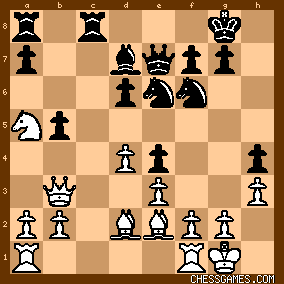
click for larger view |
|
Mar-08-19
 | | keypusher: II
<AlphaZero uses a spare moment to tighten the screw on the kingside. By fixing a white pawn on h3, Black puts the conditions in place for a future kingside pawn break with …g5-g4.> 18.Rfc1 Nc7 19.Rc2 Ncd5
The long knight’s maneuver Nd8-e6-c7-d5 has been completed. 20.Rac1
<It looks like there are going to be major exchanges taking place on the c-file. However AlphaZero takes another non-standard decision. It envisages opening the g-file on the kingside with a future …g5-g4. To exploit the resulting open file against the white king, it will need at least one major piece. For that reason, AlphaZero does not want to allow mass exchanges on the c-file. AlphaZero thus breaks a general rule and leaves White in possession of the c-file.> 20….Rxc2 21.Rxc2 a6
<Black has not been able to cover all the entry points on the c-file, but AlphaZero has assessed correctly that the white knight’s entry on the c6-square is an empty shot. For now, White has no way to exploit the c-file.> 22.Qa3

click for larger view<Played to achieve Nc6 without allowing Black the reply …Qe8 (as d6 is now hanging). If 22.Nc6 Qe8 23.Nb4 Nb6 with …a6-a5 to follow.> Incidentally, A0 has a 59.4% expected score in this position, while my SF10 shows 0.00 at 41 ply after any of 22..g5, …Qe6, or …Rc8. Sadler discusses the position at length at pp. 180-181 of <Game Changer>. Summarizing: at first glance White seems fine, with a rook on the only open file and Nb7 (ganging up on the d6-pawn) and Nc6 (threatening Bxb5) both possibilities. But the knight doesn’t actually have much to do from c6, while (as we’ll see) Black has an amazing tactical response to Nb7. Meanwhile, White’s pieces are not too well coordinated, with the rook on c2 blocking the Queen’s path back to the kingside, and Her Majesty slightly short of squares. Black has a definite space advantage, and almost all of White’s pieces are on the queenside. Black’s response to White’s threats is not defense, but counterattack! |
|
Mar-08-19
 | | keypusher: III
22….Qe6 23.Nc6
<23.Nb7 b4 is an amazing resource, exploiting the restricted position of the white queen: 24.Bxb4 (24.Qb3 a5 shows the power of Black’s queenside pawns and the constricted position of the white queen. As well as …a5-a4 followed by …Rc8, Black threatens …Ra7, trapping the knight!; 24.Qa5 Qe7 and the knight on b7 is again in big trouble!; 25.Bxb4 Bb5 26.Bxb5 Qxb7 27.Bc6 Qxb4 is the tactic. 28.Qxb4 Nxb4 attacks the rook on c2 and leaves Black a piece up) 24….Rb8 25.Bxa6 Nxb4 26.Qxb4 Qxa2 27.Qxd6 (27.Qc4 Qxc4 28.Rxc4 Ra8 traps the white bishop on a6!) 27….Ra8 28.Bf1 Qb1 followed by …Ra1 wins for Black. Tactics all based around the poor positions of White’s major pieces.> 
click for larger view23….a5
<A great idea from AlphaZero, diverting White’s pieces from the kingside and thus increasing the strength of a subsequent black kingside attack with ….g7-g5-g4. Yes, that’s right: ….g7-g5-g4 is coming, opening an attacking front on the opposite side of the board. The key question is: why shouldn’t Black just launch a kingside attack straightaway with 23….g5?23….g5 24.Ba5. The engines’ favourite defense, and not an obvious one at all. White solidifies its grip on the queenside dark squares and consolidates the posts of a few key pieces. In particular, the queen on a3 maintains her attack on the d6-square, which restricts the movement and the attacking potential of the black queen. 24….Kh7 (24….g4 is too rash, and justifies White’s idea completely: 25.hxg4 Nxg4 26.Bxg4 Qxg4 27.Qxd6 Qd1+ (27….h3 28.f3 exf3 29.Ne5; I can’t see a way to beat this… and nor can my engine!) 28.Kh2 Qxc2 29.Qxd7 Nf7 30.Ne7+ Kf8 31.Qd6 (amazing! White is winning according to my engines) 31….Ng4+ 32.Kh3 Nxf2+ 34.Kxh4 and Nf5+ is a deadly threat) 25.Nb4 Rg8 26.Qb3 makes good use of the qeeun and knight. The pressure on d5 makes it hard for Black to break with …g5-g4. 23….a5 is AlphaZero’s fabulous way of improving the kingside attack, using a range of cunning and precise tactics to tie up the white pieces on the queenside at the cost of a few pawns and thus reduce the danger of a white counterattack while AlphaZero is attacking on the kingside.> Impressively, my SF 10 also prefers 23….a5, with an eval of -0.48 at 43 ply. |
|
Mar-08-19
 | | keypusher: IV
24.b4
<This move seeks to improve on the immediate capture on b5 by giving the white queen a path back to the kingside via c1. 24.Bxb5 g5 (White’s pieces are tangled up on the queenside as the knight on c6 is pinned to the bishop and cannot move) 25.Bxa5 (25.Be2, to stop 25….g4, is met by 25….Rc8, pinning the knight to the rook on c2. How White wishes it had placed the rook on c1! 26.Qa4 g4 is very dangerous. White cannot escape the pin on the knight while Black’s attack is gathering strength on the kingside) 25….g4 (look at the White pieces on the queenside! The knight on c6 is pinned to the bishop on b5 and the bishop on a5 is pinned to the queen on a3) 26.hxg4 and now 26….h3 27.gxh3 Nxg4 28.Bf1 Nh6 is exceedingly strong for Black, who will follow up with …Kh7, …Rg8 (the reason Black didn’t exchange this rook on the c-file) and …Qg6;
24.Bxa5 b4 25.Qa4 (if 25.Nxb4 Nxb4 26.Qxb4 Qxa2 wins: that loose rook on c2 again) 25….Kh7 was suggested by my engines and looks unpleasant again for White: 26.Qb5 (26.Bb5 Qf5 27.Rc1 g5 is full of danger for White [-2.78 at 31 ply per SF 10]) 26….Ne7 Winning material. This is the point of …Kh7: Nxe7 is no longer with check;
24.Nxa5 b4 25.Bxb4 Nxb4 26.Qxb4 Qxa2 27.Nb3 Qb1+ 28.Rc1 Qxb2 29.Bd1 Be6 is a little better for Black according to my engines [SF 10’s eval is -0.39 at 40 ply]. Black could also consider wilder ideas such as 24….g5, punting the kingside attack instead of regaining material.> 24….a4
<It’s time to take stock after Black’s sequence 23….a5 and 24….a4.> 
click for larger view
<The attack on the white queen on d6 has been blocked. This means that the black queen has regained its freedom to move. Moreover, the inclusion of …a5-a4 and b2-b4 has prevented White from pressuring the knight on d5 with Qb3 and Nb4. Two themes have been active in the preceding moves:
The restriction of White’s pieces, particularly the awkward logjam of pieces on the queenside (queen, knight, and rook).
A kingside attack.
AlphaZero has turned the first lever until the conditions for the second theme are perfect. In other words, some outstanding prophylactic work has been done to prepare conditions for attack. It can be argued that 24.b4 allows the white queen to return to the kingside and thus bolster White’s defence. This is true, but the white queen does not have an active posting on the kingside: it can only stay behind the lines and try and shore up a weak square like g2. This is completely different to the lines we were seeing when White managed to play Qa3xd6. It appears that other engines possess the raw materials to take a similar decision. For example, they all spot clever tactics based on …b5-b4, and they all understand that White should fix Black’s queenside structure and secure the b4-square for the knight with 24.Ba5 (which is a superb defence). However, the other engines don’t seem to attach as much importance to the kingside attack as AlphaZero does. The engines are often looking at plans of neutralizing the c-file with …Rc8, which I don’t think was ever part of AlphaZero’s plan. Even when the attack gets going, the evaluation of the engines is relatively ‘fragile’: the evaluation jumps enormously in White’s favour after an AlphaZero move (28….Qg5 [as we’ll see, my SF10 is also unenthusiastic about Black’s 28th move]) before slowly subsiding again the further the engines analyze. By contrast, AlphaZero thinks the kingside initiative is powerful. After 24….a4, AlphaZero evaluates the position as an 80.9% expected score for Black!> |
|
Mar-08-19
 | | keypusher: V 25.Bxb5 g5
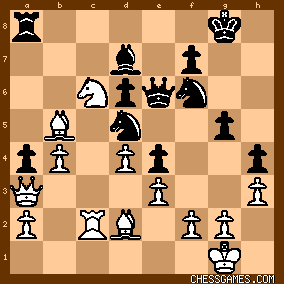
click for larger view<Here we go! AlphaZero is at an 81.6% expected score for Black, which is very confident. I’m with AlphaZero on this one: Black’s attack scares me like crazy! The g-file will be opened and then Black’s decision not to contest the c-file will come into its own.> My SF10 is -1.93 at 45 ply. 26.Qc1 <26.Be2 g4 27.hxg4 Nxg4 28.Qc1 h3 29.gxh3 Nh2 is the gorgeous idea I spotted!> 26….g4 27.hxg4 Qxg4 28.Qc1
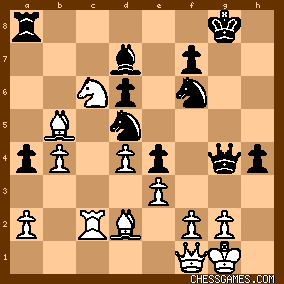
click for larger view28….Qg5
<A beautiful coordinating move, after which AlphaZero estimates an 88.5% expected score for Black. The move gets out of the path of White’s defence f2-f3, frees the c8-h3 diagonal for Black’s light-square bishop to approach the white king and eyes the loose bishop on b5. After this move, Black’s queen and bishop have designs on both the kingside and queenside.> Sadler might have gotten a little carried away here. My SF10’s first choice for a long time is 28….h3, with an illustrative line running 29.Be2 Qh4 30.Rc1 hxg2 31.Qxg2+ Kh7 32.Qh2 Bh3 33.Kh1 Ng4 34.Bxg4 Qxg4 35.Rg1 Qf3+ 36.Rg2 Rg8 37.Qxh3+! Qxh3+ 38.Rh2 Qxh2+ 39.Kxh2 and Black shouldn’t have too much trouble winning the ending. At 40 ply/67 minutes 28….Qg6 noses ahead (-3.61), followed by 28….h3 (-3.53), with A0’s move a rather distant third (-2.75). As with AlphaZero vs Stockfish, 2018, A0 is better than its opponent at devising long-term attacks, but SF sometimes executes those attacks more precisely. 29.Rc1
<A) 29.f4 Qh6. This static position is clearly better for Black. Black will play …Kh8/h7 and …Rg8 with a huge preponderance of forces on the kingside. My engines give Black a big advantage;B) 29.f3 feels like the best practical chance as loosening Black’s central grip gives upe of getting the knight back into play, while the resource …exf3, e3-e4 can throw some confusion into Black’s ranks. However, my engine goes straight for the line that I eventually decided was clearly better for Black…and gives it -2.23! 29….h3 is very powerful: 30.fxe4 Nxe4 31.Qf3 (31.Ne5 h2+ 32.Kxh2 Qh5+ is the trick I spotted! 33.Kg1 Bxb5 34.Qxb5 Qd1+ 35.Kh2 Kg7 (as I did this one!) 36.Qxd5 Rh8#) 31…Qh4 32.gxh3 Ng5 33.Qg2 Kh8 with …Nxh3+ to follow is just winning.> My SF 10’s favorite defense is 29.Be2 (-1.95 at 40 ply/85 minutes). It rates the alternatives analyzed in <Game Changer> at well below minus-three. However, if 29.Be2 is actually played, the evaluation starts dropping. |
|
Mar-08-19
 | | keypusher: VI
29….Kh8 30.Na5 Bg4 31.Be2 Bf3(!) 32.Kh1 Bxe2 33.Qxe2 Nh5 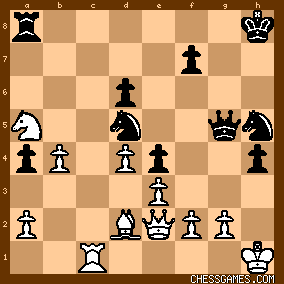
click for larger view<The engine evaluations start to turn as they spot the power of Black’s …Ng3 idea (using the outpost provided by the h4-pawn).> 34.Kh2
34.Kg1 Rg8 35.Qf1 Ng3 36.fxg3 hxg3 37.Qxf7 Qh6 38.Qf5 Qh2+ 39.Kf1 Qh1+ 40.Ke2 Qxg2+ 41.Kd1 Qf3+ 42.Qxf3 exf3. 
click for larger view<And nothing will stop those pawns!> 34….Rg8 35.f4 Qg3+ 36.Kg1 Qf3
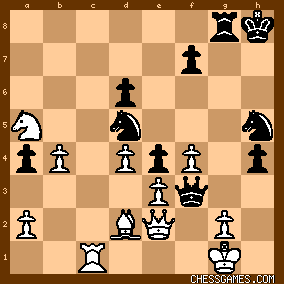
click for larger view<Look at Black’s wonderful knight on d5 and the open g-file, look at the lonely white knight on a5 and Stockfish’s useless control of the c-file, and look at White’s vulnerable king. The triumph of AlphaZero’s supreme strategy!> 37.Qxf3 exf3 38.g4 Ng3 39.Kf2 Ne4+ 40.Kxf3 Nxd2+ 41.Ke2 Ne4 0-1 <There are many more examples of this technique, but I hope the message is clear! AlphaZero is extremely strong in switching the focus of play to the opposite wing when it spots passive pieces or a weakly defended kingside.> |
|
| Mar-08-19 | | scholes: Here Mathew Sadler discusses Leela style :
https://www.youtube.com/watch?v=cMs... Review of Tcec superfinal by Mathew Sadler:
http://www.chessdom.com/the-tcec14-... |
|
Mar-08-19
 | | keypusher: <scholes >. Thanks, very interesting. I wonder if the games without preset openings they talk about in the video are available anywhere. |
|
| Mar-09-19 | | scholes: They are available here
https://cd.tcecbeta.club/archive.ht... |
|
Mar-09-19
 | | Check It Out: <scholes> great resource, thank you. |
|
Mar-09-19
 | | keypusher: <scholes: They are available here > And thank you again! Sorry to keep peppering you with questions, but are you familiar with a writeup of that match? I'm very curious...for one thing, A0 never plays 1.e4 of its own volition, while Lc0 doesn't seem to play anything else. |
|
| Mar-09-19 | | scholes: Leela is completely deterministic. If same position is there it plays the same move almost always. So if it plays e4 100% of time, it does not mean it likes e4 100%. Why network prefers certain openings is like blackbox. Different training run has different evolution of openings. One earlier training run of leela (test 10) liked to reply to Sicilan Najdorf to e4 and 1 d4 as white. It did not like berlin defence like A0 or tcec one (test30). here is blog on that match
http://mytcecexperience.blogspot.co... |
|
 |
 |
|
< Earlier Kibitzing · PAGE 20 OF 39 ·
Later Kibitzing> |
|
|
|






